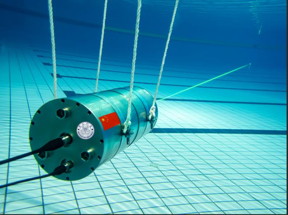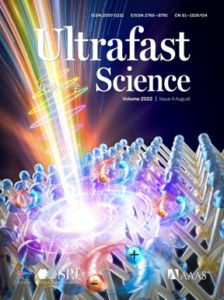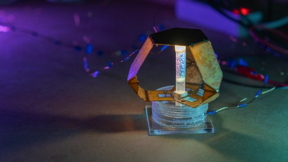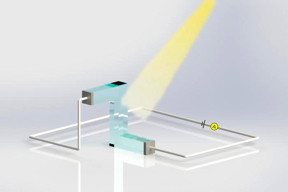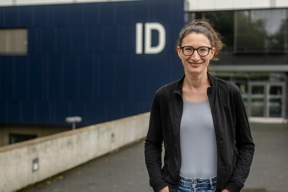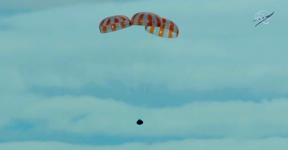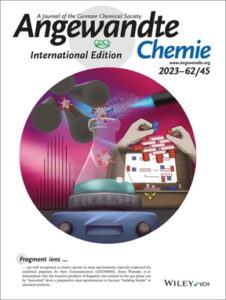Home > Press > Researchers develop technique to synthesize water-soluble alloy nanoclusters
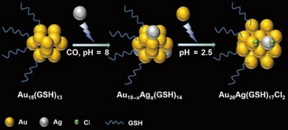 |
| Scientists from Qingdao University of Science and Technology developed a novel path to synthesize atomically precise, water-soluble alloy nanoclusters. CREDIT Xun Yuan, School of Materials Science and Engineering, Qingdao University of Science and Technology |
Abstract:
In recent years, ultrasmall metal nanoclusters have unlocked advances in fields ranging from bioimaging and biosensing to biotherapy thanks to their unique molecular-like properties. In a study published in the journal Polyoxometalates on December 11, 2023, a research team from Qingdao University of Science and Technology proposed a design to synthesize atomically precise, water-soluble alloy nanoclusters.
Researchers develop technique to synthesize water-soluble alloy nanoclusters
Tsinghua, China | Posted on January 12th, 2024“The novelty of this study is in a new strategy for the synthesis of water-soluble alloy nanoclusters and a further contribution to the fundamental understanding of the alloying mechanism of metal nanoclusters,” said study author Xun Yuan from Qingdao University of Science and Technology.
“The ultimate goal is to develop such alloy nanoclusters as novel nanomedicine,” Yuan said.
Nanoclusters are made of only a few to tens of atoms, and the size of their cores is usually below 2 nanometers (nm). Since the ultra-small size of the clusters is close to the Fermi wavelength of electrons, the continuous band turns to discontinuous and becomes molecule-like with discrete energy levels. Consequently, the nanoclusters exhibit unique optical and electronic characteristics.
Recent studies have demonstrated how alloy nanoclusters — synthesized by combining two or more different metals into a monometallic nanocluster framework — can generate new geometric structures and additional functionality. Researchers can “tune” the physical and chemical properties (e.g., optical, catalytic, and magnetic) of metal nanoclusters. Moreover, alloy nanoclusters often exhibit synergistic or new properties, which go beyond those of monometallic nanoclusters.
Heightened interest in potential opportunities has spurred recent activity to develop new methods to synthesize alloy nanoclusters. But, while the correlations between size, morphology, and composition of alloy nanoclusters and their physicochemical properties have been well demonstrated, issues surrounding doping processes and the dynamic responses are not well understood, according to Yuan.
“These unresolved issues are mainly due to the technical limitations in characterizing the alloy atom distribution at the atomic level, especially in real-time tracking of the dynamic heteroatom movement in the alloy nanoparticles during the reactions,” Yuan said.
In addition, most of those methods were exploited for hydrophobic alloy nanoclusters, which may preclude synthesis for water-soluble alloy nanoclusters. Given the wide application of water-soluble alloy nanoclusters in biomedicine and environmental protection, developing novel synthetic strategies of water-soluble alloy nanoclusters at the atomic level is significantly important.
With this goal in mind, Yuan and collaborators found that seeding silver (Ag) ions could trigger the transformation from gold (Au)-based nanoclusters into alloy Au18-xAgx(GSH)14 nanocluster which can be further transformed to composition-fixed Au26Ag(GSH)17Cl2 nanoclusters by gold (Au) ions— with GSH denoting water-soluble glutathione. Moreover, the position of the single Ag atom of Au26Ag(GSH)17Cl2 nanoclusters could be identified on the surface.
“Our results could achieve the atom-level modulation of metal nanoparticles, and provide a platform for producing alloy functional nanomaterials for specific applications,” said Yuan. “Additionally, the acquired alloying mechanism may deepen the understanding on the properties-performance of alloy nanomaterials, contributing to the generation of new knowledge in the fields of nanomaterials, chemistry, and nanocluster science.”
In future studies, the researchers will use these alloy nanoclusters for biomedical applications.
The research is supported by the National Natural Science Foundation of China and the Taishan Scholar Foundation of Shandong Province.
Other contributors include Shuyu Qian, Fengyu Liu, Haiguang Zhu, Yong Liu, Ting Feng and Xinyue Dou from Qingdao University of Science and Technology.
####
About Tsinghua University Press
About Polyoxometalates
Polyoxometalates is a peer-reviewed, international and interdisciplinary research journal that focuses on all aspects of polyoxometalates, featured in rapid review and fast publishing, sponsored by Tsinghua University and published by Tsinghua University Press. Submissions are solicited in all topical areas, ranging from basic aspects of the science of polyoxometalates to practical applications of such materials. Polyoxometalates offers readers an attractive mix of authoritative and comprehensive Reviews, original cutting-edge research in Communication and Full Paper formats, Comments, and Highlight.
About SciOpen
SciOpen is a professional open access resource for discovery of scientific and technical content published by the Tsinghua University Press and its publishing partners, providing the scholarly publishing community with innovative technology and market-leading capabilities. SciOpen provides end-to-end services across manuscript submission, peer review, content hosting, analytics, and identity management and expert advice to ensure each journal’s development by offering a range of options across all functions as Journal Layout, Production Services, Editorial Services, Marketing and Promotions, Online Functionality, etc. By digitalizing the publishing process, SciOpen widens the reach, deepens the impact, and accelerates the exchange of ideas.
For more information, please click here
Contacts:
Mengdi Li
Tsinghua University Press
Office: 86-108-347-0580
Copyright © Tsinghua University Press
If you have a comment, please Contact us.Issuers of news releases, not 7th Wave, Inc. or Nanotechnology Now, are solely responsible for the accuracy of the content.
| Related Links |
| Related News Press |
News and information
![]() Rice University launches Rice Synthetic Biology Institute to improve lives January 12th, 2024
Rice University launches Rice Synthetic Biology Institute to improve lives January 12th, 2024
![]() Development of zinc oxide nanopagoda array photoelectrode: photoelectrochemical water-splitting hydrogen production January 12th, 2024
Development of zinc oxide nanopagoda array photoelectrode: photoelectrochemical water-splitting hydrogen production January 12th, 2024
Chemistry
![]() Focused ion beam technology: A single tool for a wide range of applications January 12th, 2024
Focused ion beam technology: A single tool for a wide range of applications January 12th, 2024
Nanofabrication
![]() Shrinking hydrogels enlarge nanofabrication options: Researchers from Pittsburgh and Hong Kong print intricate, 2D and 3D patterns December 29th, 2022
Shrinking hydrogels enlarge nanofabrication options: Researchers from Pittsburgh and Hong Kong print intricate, 2D and 3D patterns December 29th, 2022
![]() Semi-nonlinear etchless lithium niobate waveguide with bound states in the continuum November 4th, 2022
Semi-nonlinear etchless lithium niobate waveguide with bound states in the continuum November 4th, 2022
Possible Futures
![]() Focused ion beam technology: A single tool for a wide range of applications January 12th, 2024
Focused ion beam technology: A single tool for a wide range of applications January 12th, 2024
![]() 'Sudden death' of quantum fluctuations defies current theories of superconductivity: Study challenges the conventional wisdom of superconducting quantum transitions January 12th, 2024
'Sudden death' of quantum fluctuations defies current theories of superconductivity: Study challenges the conventional wisdom of superconducting quantum transitions January 12th, 2024
![]() Rice University launches Rice Synthetic Biology Institute to improve lives January 12th, 2024
Rice University launches Rice Synthetic Biology Institute to improve lives January 12th, 2024
Nanomedicine
![]() Focused ion beam technology: A single tool for a wide range of applications January 12th, 2024
Focused ion beam technology: A single tool for a wide range of applications January 12th, 2024
![]() Presenting: Ultrasound-based printing of 3D materials—potentially inside the body December 8th, 2023
Presenting: Ultrasound-based printing of 3D materials—potentially inside the body December 8th, 2023
![]() VUB team develops breakthrough nanobody technology against liver inflammation December 8th, 2023
VUB team develops breakthrough nanobody technology against liver inflammation December 8th, 2023
Discoveries
![]() Focused ion beam technology: A single tool for a wide range of applications January 12th, 2024
Focused ion beam technology: A single tool for a wide range of applications January 12th, 2024
![]() 'Sudden death' of quantum fluctuations defies current theories of superconductivity: Study challenges the conventional wisdom of superconducting quantum transitions January 12th, 2024
'Sudden death' of quantum fluctuations defies current theories of superconductivity: Study challenges the conventional wisdom of superconducting quantum transitions January 12th, 2024
Announcements
![]() Scientists use heat to create transformations between skyrmions and antiskyrmions January 12th, 2024
Scientists use heat to create transformations between skyrmions and antiskyrmions January 12th, 2024
![]() Bridging light and electrons January 12th, 2024
Bridging light and electrons January 12th, 2024
![]() Development of zinc oxide nanopagoda array photoelectrode: photoelectrochemical water-splitting hydrogen production January 12th, 2024
Development of zinc oxide nanopagoda array photoelectrode: photoelectrochemical water-splitting hydrogen production January 12th, 2024
Interviews/Book Reviews/Essays/Reports/Podcasts/Journals/White papers/Posters
![]() Focused ion beam technology: A single tool for a wide range of applications January 12th, 2024
Focused ion beam technology: A single tool for a wide range of applications January 12th, 2024
![]() 'Sudden death' of quantum fluctuations defies current theories of superconductivity: Study challenges the conventional wisdom of superconducting quantum transitions January 12th, 2024
'Sudden death' of quantum fluctuations defies current theories of superconductivity: Study challenges the conventional wisdom of superconducting quantum transitions January 12th, 2024
Nanobiotechnology
![]() Focused ion beam technology: A single tool for a wide range of applications January 12th, 2024
Focused ion beam technology: A single tool for a wide range of applications January 12th, 2024
![]() Presenting: Ultrasound-based printing of 3D materials—potentially inside the body December 8th, 2023
Presenting: Ultrasound-based printing of 3D materials—potentially inside the body December 8th, 2023
![]() VUB team develops breakthrough nanobody technology against liver inflammation December 8th, 2023
VUB team develops breakthrough nanobody technology against liver inflammation December 8th, 2023
- SEO Powered Content & PR Distribution. Get Amplified Today.
- PlatoData.Network Vertical Generative Ai. Empower Yourself. Access Here.
- PlatoAiStream. Web3 Intelligence. Knowledge Amplified. Access Here.
- PlatoESG. Carbon, CleanTech, Energy, Environment, Solar, Waste Management. Access Here.
- PlatoHealth. Biotech and Clinical Trials Intelligence. Access Here.
- Source: http://www.nanotech-now.com/news.cgi?story_id=57444
- :has
- :is
- :not
- 000
- 10
- 11
- 12th
- 2023
- 28
- 2D
- 3d
- 4th
- 7
- 7th
- 8th
- 9th
- a
- accelerates
- access
- According
- accuracy
- Achieve
- acquired
- across
- activity
- addition
- Additional
- advances
- advice
- AG
- against
- All
- Alloy
- an
- analytics
- and
- Application
- applications
- ARE
- areas
- Array
- AS
- aspects
- At
- atom
- atomic
- attractive
- Australia
- author
- awarded
- away
- BAND
- basic
- BE
- Beam
- becomes
- been
- below
- between
- Beyond
- biology
- biomedical
- bound
- breakthrough
- but
- by
- CAN
- capabilities
- carbon
- Center
- CGI
- challenges
- characteristics
- chemical
- chemistry
- China
- click
- Close
- co2
- collaborators
- COM
- combining
- comment
- comments
- commitment
- Communication
- community
- compatible
- composition
- comprehensive
- Condensed matter
- Consequently
- content
- continuous
- contributing
- contribution
- contributors
- conventional
- Conversion
- correlations
- could
- create
- created
- credit
- Current
- cutting-edge
- Death
- December
- Deepen
- deepens
- del
- delivery
- demonstrated
- Design
- develop
- developed
- developing
- Development
- develops
- Devices
- different
- direct
- discover
- discovery
- distribution
- down
- due
- during
- dynamic
- e
- each
- Editorial
- effects
- Electronic
- electrons
- Emissions
- end
- end-to-end
- energy
- Engineering
- enlarge
- ensure
- environmental
- especially
- establishing
- etc
- Ether (ETH)
- Even
- exchange
- exhibit
- expert
- exploited
- FAST
- featured
- few
- Fields
- findings
- fluctuations
- focuses
- For
- found
- Foundation
- Framework
- from
- full
- functional
- functionality
- functions
- fundamental
- further
- future
- GAS
- generate
- generating
- generation
- gif
- given
- Go
- goal
- Gold
- Graphene
- greenhouse gas
- Harvesting
- Have
- help
- Highlight
- Hong
- Hong Kong
- hosting
- How
- HTML
- http
- HTTPS
- hydrogen
- ideas
- identified
- Identity
- identity management
- if
- Imaging
- Impact
- important
- improve
- in
- Inc.
- include
- inflammation
- information
- innovative
- innovative technology
- inside
- Institute
- interest
- International
- into
- intricate
- issues
- ITS
- January
- journal
- jpg
- knowledge
- Kong
- launches
- Layout
- Level
- levels
- light
- limitations
- links
- lithium
- Liver
- made
- mainly
- make
- management
- market-leading
- Marketing
- materials
- Matter
- May..
- measurement
- mechanism
- metal
- Metals
- methods
- methods Were
- mind
- mix
- more
- Moreover
- most
- movement
- mRNA
- nano
- Nanomaterials
- Nanomedicine
- nanotechnology
- National
- Natural
- Nature
- net
- New
- New Zealand
- news
- Noble
- novel
- novelty
- November
- now
- of
- offering
- Offers
- offset
- often
- on
- online
- only
- open
- opened
- opportunities
- Optimize
- Options
- or
- original
- Paper
- particle
- partners
- path
- Paul
- peer
- peer-reviewed
- Photons
- PHP
- physical
- Physics
- pittsburgh
- platform
- plato
- Plato Data Intelligence
- PlatoData
- please
- position
- possibly
- Post
- posted
- potent
- potential
- power
- Practical
- Practical Applications
- precise
- press
- Press Release
- printing
- process
- processes
- producing
- Production
- professional
- promise
- Promotions
- prompts
- properties
- proposed
- protection
- provide
- provides
- providing
- published
- Publishing
- Quantum
- quantum technology
- range
- ranging
- rapid
- reach
- reactions
- readers
- real-time
- recent
- reduces
- release
- Releases
- research
- researchers
- resource
- responses
- responsible
- Results
- return
- review
- Reviews
- Rice
- Room
- s
- Said
- Save
- Scholar
- School
- Science
- Science and Technology
- scientific
- scientists
- Search
- sensor
- September
- Services
- Share
- Shows
- significant
- significantly
- Silver
- since
- single
- SIX
- Size
- small
- snowflakes
- solely
- solicited
- solid
- something
- Source
- specific
- Sponsored
- start
- States
- strategies
- Strategy
- structures
- studies
- Study
- submission
- Submissions
- submit
- such
- sudden
- suggest
- Superconductivity
- Supported
- Surface
- Surrounding
- synergistic
- synthesis
- synthesize
- synthetic
- Systems
- Tandem
- team
- Technical
- technique
- Technology
- tens
- thanks
- that
- The
- their
- These
- this
- those
- to
- tool
- toronto
- Tracking
- Transformation
- transformations
- transformed
- trigger
- Tsinghua
- turns
- two
- ultimate
- understanding
- understood
- Unexpected
- unique
- university
- us
- use
- used
- usually
- Vaccine
- Wave
- Way..
- WELL
- were
- which
- while
- wide
- Wide range
- will
- wisdom
- with
- working
- Yahoo
- years
- you
- Yuan
- Zealand
- zephyrnet










